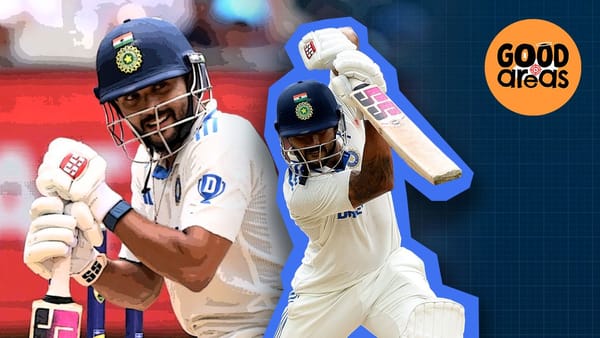Fast bowling in Asia
Some interesting trends through history. Plus, fun Dhammika Prasad facts.
Dennis Lillee played four of his 70 Tests in Asia. His average is poor in those three matches, but it is three matches. India would often ask a batter to take on the new ball duties.
Western teams quite often head to Asia with whatever spinner they find in their sofa cushions. A sort of mad dash to convince a spinner that they are of Test quality just before going up against some of the best players of spin in the world. (Cameron White).
But with Tim Southee’s five-wicket haul, on top of Kyle Jamieson’s three wickets on day one, I started to think about the fact that seam in Asia seems to have been doing pretty well over the last few years.
After two days the seamers have eight of the ten wickets. While this might have something to do with the way the spinners have bowled, I thought it was worth asking the question.
Because if nothing else, this is the greatest era of Indian fast bowling, and even Suranga Lakmal has turned himself into a top-quality seamer. And let us also remember that playing quick bowling has become harder around the world, so it would make sense that Asia was part of this.
And yeah, seam has got very hard to play in Asia.

In 2019 the average was lower than a Nice Inch Nails song, seamers averring 26 in Asia. This was from 8000 balls too. It’s the only year in the ball by ball year where seam was lower than 30, and it was way lower. But it hasn’t really bounced back either. From 06 to 2014 seam averaged over 40 three times, and never went below 35. Since then it has been under 35 every year bar one.
This isn’t just Asia though, I dubbed this the seam playing pandemic a while back, and it’s affected batters no matter what continent they face it on. Quicks are just getting more wickets.

The history of the game is actually weirder, as until the year 2000, every decade seam averaged better than spin in Asia.

And this may not mean that seam was under bowled, just bowled when conditions were in their favour. But that suggests that perhaps either Asian teams struggled to develop seamers, or touring teams often turned up with poor spinners when seamers were their strength.
But in the ball by ball era, spin has been better other than the odd year, until two years in a row seam dropped below it.

2020 there wasn’t as much cricket played as usual, but there were still more than 10000 balls bowled in Asia, and a good 20% of them were seam. And you can see that even in 2018 and 2020 the average for seam has been quite low. But the pattern does seem to go down from 2015 until now.
It does for pace as well; it is much harder to bat in Asia now than it was before, no matter what you face.

And the averages show that quite nicely if you look at the last six years compared to the decade before.
But I also went and found bowlers who had delivered 1000 balls in Asia in each period to see how they had gone. There isn’t that many, but um, like all of them got better.

Special shout out to Dhammika Prasad in this, by the way, that’s some transformation.
I did look at India on their own as well, just to see where they were in this pace bowling revolution. Because while Sri Lanka has had Lakmal and Prasad turn things around. In many ways, over the last decade, India has turned itself into a major force in pace bowling.

Look at how many of their highest wicket-takers are current bowlers.
And having all those wicket-taking seamers seems to have worked pretty well for India, last three years they’ve had home Tests; well, it’s been hovering around 25.

That’s low low. Low, low, low.
The weirder thing is that the percentage of seam used doesn’t always correlate with its success.

Like over the last six years, seamers have done well in India, but the percentage of it used is far lower earlier this century then they were struggling.
What makes more sense, is that traditionally in Asia, around 50% of the deliveries have been spin, as spinners have surpassed seamers in average, which has dropped under 40 over the last decade and change.

What is probably true now is that we pick seamers when they are better suited to Asian conditions. Overseas bowlers prepare in a way that wasn’t available to Dennis Lillee. Sunil Gavaskar probably isn’t getting too many overs these days. Asian seamers have reverse swing, are treated and developed better.
But some of it is just that right at the moment, there are a lot of things in favour of seam bowlers, and that matters everywhere, even on a flat pitch in Green Park.
🎙 New Red Inker 🎙
— Jarrod Kimber (@ajarrodkimber) 9:40 AM ∙ Nov 24, 2021
Moving to Off with Cameron Ponsonby
We chat about Graham Gooch’s baseball stance, Steve Smith, Kevin Pietersen, LBW rates, how much red ball cricket has changed and where your toes should be while you are batting.
anchor.fm/redinker/episo…
— Jarrod Kimber (@ajarrodkimber) 7:04 AM ∙ Nov 26, 2021




